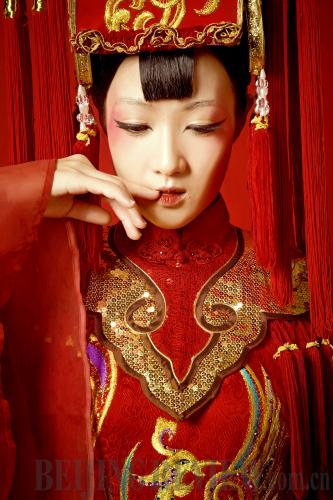|
 |
|
Unlike the white wedding gown that symbolizes purity in Western culture, the ancient East used resplendent red to represent blessings for a daughter getting married (CAEG) |
Dance performance The Red Dress on March 6 will take the stage at New York's David H. Koch Theater in Lincoln Center. Based on Chinese folk customs, the performance is another masterpiece of the China Arts and Entertainment Group (CAEG), and will display a magnificent dream from the boudoir of a young girl in south China before an American audience.
The Red Dress (in Chinese, literally "The Ten-Mile Red Dowry") draws its source material from the wedding customs of China's Jiangnan region (the lands south of the lower Yangtze River, including Shanghai and Ningbo). It tells a bittersweet and beautiful love story. In an old town, a boy named Ayong and a girl named Yue'er are childhood playmates, and, in the first bloom of love pledge to marry. Ayong promises Yue'er he will "return home in silken robes and take her as his bride" and leaves town to make a living. Time passes and Ayong's fellow workers all return home, but Ayong himself disappears without a trace. Yue'er, alone in her imagination, longs for the festivity and joy of the "ten-mile red dowry" of her wedding day, and waits in her beautiful dreams.
Unlike the white wedding gown that symbolizes purity in Western culture, the ancient East used resplendent red to represent blessings for a daughter getting married. The "ten-mile red dowry" is a wedding custom in the eastern part of east China's Zhejiang Province with a long history and deep historical-cultural significance. Since ancient times, Zhejiang has been a rich and populous region. Local wealthy households would send their daughters to be married with splendid marriage processions with everything decorated in fine red paint. The dowry would include a marriage bed, a bridal trousseau, sewing paraphernalia and other treasures. The procession would stretch for miles, expressing the parents' earnest blessings for their daughter, forming an impressive "ten-mile red dowry."
The Red Dress took five years to produce and has already been performed over 100 times at home and abroad. It is performed by the Ningbo Music and Dance Troupe and stars Cheng Lin as the patient maiden Yue'er. Director Wang Xiaoying is deputy director of the National Theater of China and has a unique understanding and method of presenting Chinese traditional culture on stage. His works demonstrate how he has inherited the Chinese aesthetic tradition and abound with meaning and is rich in poetic flavor. In The Red Dress, Wang Xiaoying incorporated consideration of the fate of women in old China, making "dreams" the soul of the whole production, and displaying the grace and tenacity of Chinese women in vivid detail before the audience, to narrate a tragic love story.
To put on the magnificent marriage scene in The Red Dress, the play uses nearly 400 red dowry utensils—a red sedan chair, a red vest, a red marriage bed, a red trunk, a red bucket, a red veil—all meticulously crafted by 40 stage art technicians who worked 16 hours a day for two months and built a "Daughter's Tower" filled with bridal ornaments on the stage.
The scene is grand and ornate and will give spectators cause to marvel. The Red Dress could be called a theatrical panorama of Jiangnan customs. The banter of the matchmaker and the hooper, the tender Ningbo dialect in the background music, the wedding custom "betrothed by wine, married with wine" (whereby parents bury wine when their daughter is born and retrieve it to entertain guests at her wedding), the water falling like opalescent petals when the girls wash their braids during the Girls' Festival—scene after scene bursting with life, vividly portraying the culture, as if projecting an exquisite painting of Jiangnan life on the stage.
The Red Dress also bears the weight of the homesickness of many overseas Chinese. While in New York, the audience can experience firsthand the grandest and most brilliant moment in the life of a woman in old China. In the performance, the bridal sedan, trousseau, and other implements—those precious dowry pieces—will debut in the bustling city of New York, and in between classic and contemporary form a bridge that transcends space and time.
The China Arts and Entertainment Group (CAEG), the first large publicly-owned cultural enterprise, was inaugurated after the merger of the China Performing Arts Agency (CPAA) and the China International Exhibition Agency, as a major step to transform Chinese culture and art institutions into modern enterprises. They are under the auspice of the Ministry of Culture, undertaking cultural exchange projects to promote and enhance Chinese culture in other countries. CAEG annually runs more than 5,000 shows, exhibitions and comprehensive cultural activities in hundreds of cities, regions, and in countries around the world.
(Reporting from New York City, Kieran Maynard contributed to the story) |
